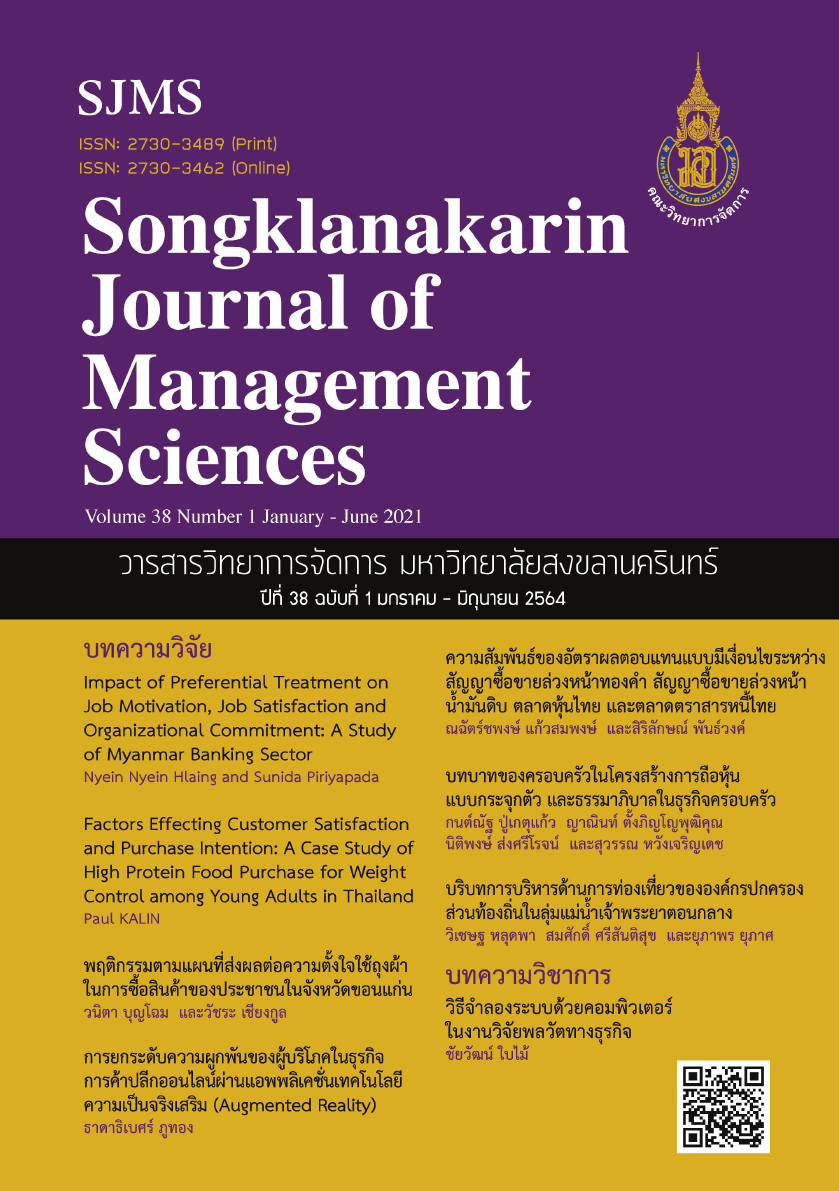พฤติกรรมตามแผนที่ส่งผลต่อความตั้งใจใช้ถุงผ้าในการซื้อสินค้าของประชาชนในจังหวัดขอนแก่น
Main Article Content
บทคัดย่อ
งานวิจัยนี้มีวัตถุประสงค์เพื่อศึกษาปัจจัยที่มีผลต่อความตั้งใจใช้ถุงผ้าในการซื้อสินค้าของประชาชนในจังหวัดขอนแก่น โดยใช้ทฤษฎีพฤติกรรมตามแผน (Ajzen, 1991; Chang & Chou, 2018; Taufique & Vaithianathan, 2018; Ekasari, 2018) กลุ่มตัวอย่างที่ใช้ในการวิจัยได้แก่ ประชาชนในจังหวัดขอนแก่น จำนวน 400 คน โดยใช้วิธีการสุ่มตัวอย่างแบบบังเอิญ ใช้แบบสอบถามเป็นเครื่องมือในการเก็บรวบรวมข้อมูล สถิติที่ใช้ในการวิเคราะห์ข้อมูล ได้แก่ ค่าเฉลี่ย ค่าส่วนเบี่ยงเบนมาตรฐาน การทดสอบตัวแปร 2 กลุ่มที่เป็นอิสระจากกัน การวิเคราะห์ความแปรปรวนทางเดียว สัมประสิทธิ์สหสัมพันธ์ และการวิเคราะห์การถดถอยพหุคูณ ผลการศึกษาพบว่า ปัจจัยทัศนคติที่มีต่อพฤติกรรมด้านความคาดหวัง ปัจจัยการรับรู้ถึงการควบคุมพฤติกรรมด้านความสนใจ และปัจจัยการรับรู้ถึงการควบคุมพฤติกรรมด้านกิจกรรมส่งเสริมส่งผลต่อความตั้งใจใช้ถุงผ้าในการซื้อสินค้าของประชาชนในจังหวัดขอนแก่น หน่วยงานภาครัฐสามารถนำผลวิจัยไปใช้วางนโยบายหรือกลยุทธ์เพื่อสร้างความเข้าใจให้กับประชาชน เกิดทัศนคติและการรับรู้ และความตระหนักถึงการอนุรักษ์สิ่งแวดล้อมได้อย่างมีประสิทธิภาพมากขึ้น
Article Details

อนุญาตภายใต้เงื่อนไข Creative Commons Attribution-NonCommercial-NoDerivatives 4.0 International License.
บทความที่ตีพิมพ์ถือเป็นลิขสิทธิ์ของวารสารวิทยาการจัดการ มหาวิทยาลัยสงขลานครินทร์ อย่างไรก็ตาม กองบรรณาธิการไม่สงวนลิขสิทธิ์ในการทำซ้ำ คัดลอก หรือเผยแพร่ แต่จะต้องอ้างอิงให้ถูกต้องตามหลักวิชาการ
เอกสารอ้างอิง
Ajzen, I. & Fishbein, M. (1970). The prediction of behavior from attitudinal and normative variables. Journal of Experimental Social Psychology, 6(4), 466–487.
Ajzen, I. (1991). The theory of planned behaviors. Organizational Behavior and Human Decision Process, 50(2), 179-211.
Archarungroj, P. & Sirikudta, S. (2018). Motivation, Integrated Marketing Communication and Behavioral Trends in Using Eco-friendly Shopping Bags of Consumers in Bangkok Metropolitan Area. Journal of Social Sciences Srinakharinwirot University, 21, 174-193.
Bartolotta, J. F. & Hardy, S. D. (2018). Barriers and benefits to desired behaviors for single use plastic items in northeast Ohio's Lake Erie basin. Marine Pollution Bulletin, 127, 576-585.
Busse, M. & Menzel, S. (2014). The role of perceived socio-spatial distance in adolescents’ willingness to engage in pro-environmental behavior. Journal of Environmental Psychology, 40, 412-420.
Chang, S. H. & Chou, C. H. (2018). Consumer Intention toward Bringing Your Own Shopping Bags in Taiwan: An Application of Ethics Perspective and Theory of Planned Behavior. Sustainability, 10(6), 1-14.
Ekasari, A. (2018). Pengaruh Drive for Environmental Responsibility, Collectivism dan Subjective Norm terhadap Behavioral Intention Penggunaan Reusable Bag. Jurnal Manajemen dan Pemasaran Jasa, 11(2), 201-216.
Farrow, K., Grolleau, G. & Ibanez, L. (2017). Social Norms and Pro-environmental Behavior: A Review of the Evidence. Ecological Economics, 140, 1–13.
Fishbein, M., & Ajzen, I. (1975). Belief, attitude, intention, and behavior: An introduction to theory and research. Reading, MA: Addison-Wesley.
Gano-an, J. C. (2018). Consumers’ preferences on the use of eco-friendly bags: A green marketing perspective. Journal of Economics, Business, and Accountancy Ventura, 20(3), 357-362.
Jakovcevic, A., Steg, L., Mazzeo, N., Caballero, R., Franco, P., Putrino, N., & Favara, J. (2014). Charges for plastic bags: Motivational and behavioral effects. Journal of Environmental Psychology, 40, 372-380.
Lealaphan, A. & Launglaor, W. (2014). Attitudes and Behavior of Bangkok Residents regarding Reducing the Use of Plastic Bags. University of the Thai Chamber of Commerce Journal. 34(1), 70-88.
Munn, N. L. (1971). Introduction to Psychology. Boston: Houghton Muffin.
National Statistical Office. (2017). Khon Kaen Provincial Statistical Report. Retrieved October 20, 2019, from https://issuu.com/khonkaen.nso.go.th.
Nunnally, J. C. (1978). Psychometric theory (2nd ed.). New York: McGraw-Hill.
O’Brien, J. & Thondhlana, G. (2019). Plastic bag use in South Africa: Perceptions, practices and potential intervention strategies. Waste Management, 84, 320-328.
O’brien, R. M. (2007). A Caution Regarding Rules of Thumb for Variance Inflation Factors. Quality & Quantity, 41, 673–690.
Pollution Control Department. (2019). Annual Report 2018 Waste and Hazardous Substances Management Bureau. Retrieved October 18, 2019, from http://www.pcd.go.th/public/Publications/file/wsthaz61_annual.pdf
Sampradit, P. & Thongjeen, C. (2017). Media Perception, Attitude, and Social Responsibility that Affects on Thai People's Decision Making in Using Tops. Proceedings of the 7 th STOU National research conference (pp. 122-133). Nonthaburi: Sukhothai Thammathirat.
Schwartz, S. (1977). Normative influences on Altruism. Advances in experimental social psychology, 10, 221-279.
Smith, M., Cho, E., & Smith, K. R. (2016). The effects of young consumers’ perceptions of environment-friendly shopping bags and environmental consciousness on attitudes and purchase intentions. The Research Journal of the Costume Culture, 24(5), 687-696.
Spranz, R., Schlüter, A., & Vollan, B. (2018). Morals, money or the master: The adoption of eco-friendly reusable bags. Marine Policy, 96, 270-277.
Sun, Y., Wang, S., Li, J., Zhao, D. & Fan, J. (2017). Understanding consumers’ intention to use plastic bags: using an extended theory of planned behaviour model. Natural Hazards, 89, 1327–1342.
Taufique, K.M.R & Vaithianathan, S. (2018). A fresh look at understanding Green consumer behavior among young urban Indian consumers through the lens of Theory of Planned Behavior. Journal of Cleaner Production, 183, 46-55.
Tabachnick, B.G. & Fidell, L.S. (2018). Using Multivariate Statistics (7th ed). Allyn and Bacon, Boston.
Vassanadumrongdee, S., Hoontrakool, D., & Marks, D. (2020). Perception and Behavioral Changes of Thai Youths Towards the Plastic Bag Charging Program. Applied Environmental Research. 42(2). 27-45.
Xanthos, D. & Walker, T. R. (2017). International policies to reduce plastic marine pollution from single-use plastics (plastic bags and microbeads): A review. Marine Pollution Bulletin, 118(1-2), 17–26.
Yamane, T. (1970). Elementary sampling theory. Englewood Cliff, NJ: Prentice Hall.

